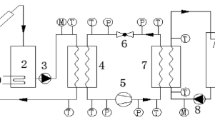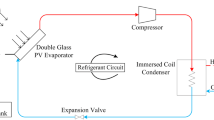Abstract
In this work, the energy performance parameters of heat pumps using a photovoltaic–thermal evaporator (PV–TE) with circular and triangular tube evaporator configurations are compared. The experimental observations were made in a heat pump under the meteorological conditions of Coimbatore city in India. The standard energy performance parameters of a heat pump (using PV–TE) such as, condenser heating capacity, coefficient of performance (COP), evaporator heat gain, solar energy input ratio and photovoltaic panel efficiency were calculated using experimental observations. The energy performance parameters of the heat pump were simulated using artificial neural networks to have a realistic energy performance comparison. The results show that triangular tube PV–TE configuration has enhanced the major energy performance parameters of the heat pump such as, condenser heating capacity, COP and panel efficiency by 3%–7%, 3%–5% and 4%–13%, respectively when compared to the circular tube PV–TE configuration.
Similar content being viewed by others
References
Amin ZM, Hawlader MNA (2013). A review on solar assisted heat pump systems in Singapore. Renewable and Sustainable Energy Reviews, 26: 286–293.
Chen H, Riffat SB, Fu Y (2011). Experimental study on a hybrid photovoltaic/heat pump system. Applied Thermal Engineering, 31: 4132–4138.
Fu HD, Pei G, Ji J, Long H, Zhang T, Chow TT (2012). Experimental study of a photovoltaic solar-assisted heat-pump/heat-pipe system. Applied Thermal Engineering, 40: 343–350.
Holman JP (2007). Experimental Methods for Engineers, 7th edn. New Delhi: Tata McGraw-Hill.
Ji J, Liu K, Chow T-T, Pei G, He H (2007). Thermal analysis of PV/T evaporator of a solar assisted heat pump. International Journal of Energy Research, 31: 525–545.
Ji J, Liu K, Chow T-T, Pei G, He W, He H (2008). Performance analysis of a photovoltaic heat pump. Applied Energy, 85: 680–693.
Kalogirou SA, Bojic M (2000). Artificial neural networks for the prediction of the energy consumption of a passive solar building. Energy, 25: 479–491.
Kara O, Ulgen K, Hepbasli A (2008). Exergitic assessment of a direct expansion solar assisted heat pump systems: Review and modeling. Renewable and Sustainable Energy Reviews, 12: 1383–1401.
Li YW, Wang RZ, Wu JY, Xu YX (2007). Experimental performance analysis on a direct expansion solar assisted heat pump water heater. Applied Thermal Engineering, 27: 2858–2868
Liu K, Ji J, Chow T-T, Pie G, He H, Jiang A, Yang J (2009). Performance study of a photovoltaic solar assisted heat pump with variablefrequency compressor—A case study in Tibet. Renewable Energy, 34: 2680–2687.
Mastrullo R, Renno C (2010). A thermo economic model of a photovoltaic heat pump. Applied Thermal Engineering, 30: 1959–1966.
Mekhilef S, Saidur R, Kamalisarvestani M (2012). Effect of dust, humidity and air velocity on efficiency of photovoltaic cells. Renewable and Sustainable Energy Reviews, 16: 2920–2925.
Mellit A, Kalogirou SA (2008). Artificial intelligence techniques for photovoltaic applications: A review. Progress in Energy and Combustion Science, 34: 574–632.
Mohanraj M, Jayaraj S, Muraleedharan C (2008). Modeling of a direct expansion solar assisted heat pump using artificial neural networks. International Journal of Green Energy, 5: 520–532.
Mohanraj M, Jayaraj S, Muraleedharan C (2009a). Environment friendly alternatives to halogenated refrigerants—A review. International Journal Green House Gas Emission and Control, 3: 108–119.
Mohanraj M, Jayaraj S, Muraleedharan C (2009b). Performance prediction of a direct expansion solar assisted heat pump using artificial neural networks. Applied Energy, 86: 1442–1449.
Mohanraj M, Jayaraj S, Muraleedharan C (2009c). A comparison of performance of a direct expansion solar assisted heat pump using R22 and mixtue of R407C–Liquified petroleum gas. Journal of Power and Energy, 223: 821–833.
Mohanraj M, Jayaraj S, Muraleedharan C (2009d). Exergy analysis of direct expansion solar assisted heat pumps using artificial neural networks. International Journal of Energy Research, 33: 1005–1020.
Mohanraj M, Jayaraj S, Muraleedharan C (2010). Exergy assessment of a direct expansion solar assisted heat pump working with R22 and R407C/LPG mixture. International Journal of Green Energy, 7: 65–83.
Mohanraj M, Jayaraj S, Muraleedharan C (2012). Applications of artificial neural networks for refrigeration, air conditioning and heat pump systems—A review. Renewable and Sustainable Energy Reviews, 16: 1340–1358.
Mohanraj M, Jayaraj S, Muraleedharan C (2015). Applications of artificial neural networks for thermal analysis of heat exchangers— A review. International Journal of Thermal Sciences, 90: 150–172.
Ozgener O, Hepbasli A (2007). A review on the energy and exergy analysis of solar assisted heat pump systems. Renewable and Sustainable Energy Reviews, 11: 482–496.
Rejeb O, Dhaou H, Jemni A (2015). Parameters effect analysis of a photovoltaic thermal collector: Case study for climatic conditions of Monastir, Tunisia. Energy Conversion and Management, 89: 409–419.
Shan F, Tang F, Cao L, Fang G (2014). Dynamic characteristics modeling of a hybrid photovoltaic–thermal solar collector with active cooling in buildings. Energy and Buildings, 78: 215–221.
Shariah A, Al-Akhras M-A, Al-Omari IA (2002). Optimizing the tilt angle of solar collectors. Renewable Energy, 26: 587–598.
Xu G, Deng S, Zhang X, Yang L, Zhang Y (2009). Simulation of a photovoltaic/thermal heat pump system having a modified collector/evaporator. Solar Energy, 83: 1967–1976.
Xu G, Zhang X, Deng S (2006). A simulation study on the operating performance of a solar–air source heat pump water heater. Applied Thermal Engineering, 26: 1257–1265.
Xu G, Zhang X, Deng S (2011). Experimental study on the operating characteristics of a novel low-concentrating solar photovoltaic/ thermal integrated heat pump water heating system. Applied Thermal Engineering, 31: 3689–3695.
Zhang X, Zhao X, Xu J, Yu X (2013). Characterization of a solar photovoltaic/loop-heat-pipe heat pump water heating system. Applied Energy, 102: 1229–1245.
Author information
Authors and Affiliations
Corresponding author
Rights and permissions
About this article
Cite this article
Mohanraj, M., Gunasekar, N. & Velmurugan, V. Comparison of energy performance of heat pumps using a photovoltaic–thermal evaporator with circular and triangular tube configurations. Build. Simul. 9, 27–41 (2016). https://doi.org/10.1007/s12273-015-0256-1
Received:
Revised:
Accepted:
Published:
Issue Date:
DOI: https://doi.org/10.1007/s12273-015-0256-1




